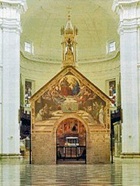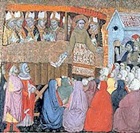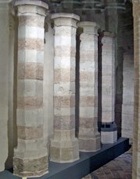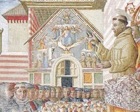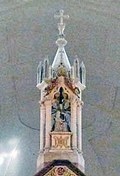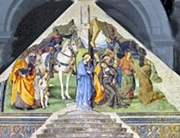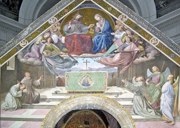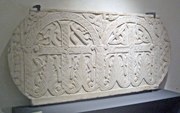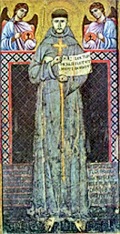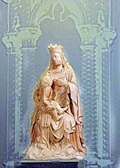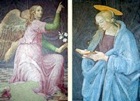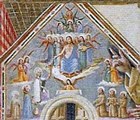This tiny church now stands presbytery of Santa Maria degli Angeli. The site on which it was built was referred to as the Portiuncula (little portion) from at least 1045. The earliest surviving documentary reference to the church of Santa Maria degli Angeli dates to 1145, when it belonged to the Abbazia di San Benedetto. However, it was probably already old by this time, and it had fallen into disrepair by the early 13th century.
St Francis and the Portiuncula
The Portiuncula was among the churches that St Francis rebuilt in 1205-6 after his vision before the Crucifix in San Damiano (see below). It was here in ca. 1208 that he heard the sermon on a text in the Gospel of St Matthew that set him on the course of evangelical poverty.
In ca. 1209, after Pope Innocent III had confirmed the proposed form of life of St Francis and his early followers, the little group needed a church in which to worship and near which they could bury their dead. They settled on the Portiuncula, and moved here from their hovel at Rivotorto. Abbot Tebaldo of San Benedetto tried to give it to them but St Francis (who did not want to own anything) insisted on paying an annual rent of a basket of fish. (The Portiuncula remained formally a possession of San Benedetto until at least 1244).
The Portiuncula provided a base for the early Franciscans, and was the place at which they met periodically when they returned to Assisi from their evangelical missions. In 1211, St Francis received St Clare here and so initiated the Order of the Poor Clares. St Francis cured Brother Moricus at the nearby hospice of San Salvatore delle Pareti, which he would have often passed as he walked to the Portiuncula from Assisi.
As the Franciscan Order became increasingly institutionalised, the Portiuncula became the location for their annual General Chapters.
-
✴Brother Jordan of Giano, one of some 3,000 friars who attended the General Chapter at there in 1221, recorded that the friars there still "lived, ate and slept in tents of branches".
-
✴When some 5,000 friars were expected to attend the so-called Chapter of Mats in the following year, the people of Assisi built a house for them. St Francis was furious and tried to demolish it with his own hands until a bystander mollified him by asserting that the house belonged to the commune of Assisi and not to the brothers.
St Francis appointed Brother Peter Catanii as his Vicar when he relinquished administrative control of the Order in 1220. Brother Peter lived at the Portiuncula and died here in 1221. His monument is in the external left wall of the church.
As long as St Francis lived, the Portiuncula remained a simple hermitage. When he returned here in 1226 knowing that he would soon die, a simple hut served as the infirmary (see below), and it was here that he died. He would have liked to have been buried here, but his relics could not have been secure so far from the city. They were translated (via San Damiano) to San Giorgio, just outside the walls of Assisi, a few days after his death.
St Bonaventure summarised the importance that the Portiuncula had for St Francis in his "Major Legend of St Francis" (1263): “This place the holy man loved more than other places in the world; for here he began humbly, here he progressed virtuously, here he ended happily. This place he entrusted to his brothers at his death as the most beloved of the Virgin”. (Chapter 2, paragraph 8)
Portiuncula in the 13th and 14th centuries
According to tradition, St Francis consecrated the Portiuncula in 1216, shortly after he had secured the
Portiuncula Indulgence. The ceremony was held in front of the church, before a congregation that included seven bishops. This illustration of it comes from the
Portiuncula Altarpiece (1393).
By 1230, the friars had begun to erect more substantial buildings around the Portiuncula, and it became their second convent in Assisi. As part of this development:
-
✴the wooden ceiling of the Portiuncula was replaced by the present stone vault; and
-
✴a chapel was built on the site of the infirmary in which St Francis had died, later to be incorporated into the Cappella del Transito.
The church became an important place of pilgrimage from the late 1260s, when people came to receive the Portiuncula Indulgence on the 1st and 2nd August each year. Pope Nicholas IV enlarged the convent in 1288 and mandated that the alms of pilgrims visiting the Portiuncula should subsequently be devoted to the needs of the Basilica di San Francesco, Assisi.
Portiuncula Altarpiece (1393)
Brother Francesco da Sangemini commissioned the Portiuncula Altarpiece for the altar wall from the priest Ilario da Viterbo.
Portiuncula and the Observant Franciscans
The convent at the Portiuncula took on a new lease of life in 1415, when it passed to the Observant Franciscans. A number of families and confraternities built oratories on the surrounding land.
In 1485, the friars built an adjoining choir behind the apse of the Portiuncula. A series of stone columns in the
Museo della Portiuncula probably came from this stricture.
They commissioned frescoes from two important artists at about this time:
-
✴in 1485, Perugino painted frescoes on the external wall of the apse (see below); and
-
✴in ca. 1492, Nicolò di Liberatore, l' Alunno painted a fresco of Christ granting the Portiuncula Indulgence on the facade (see below).
A fresco (1516) by
Tiberio d Assisi in the
Cappella delle Rose in which St Francis proclaims the granting of the Portiuncula Indulgence (the relevant detail of which is illustrated here) shows the Portiuncula:
-
✴with the fresco by l’ Alunno on the façade; and
-
✴with the choir chapel behind it. A colonnade similar to that illustrated above is exposed along its left wall (in the top left hand corner of the fresco).
In this representation of the fresco on the facade of the Portiuncula, Christ sits in judgement above the portal, which thus serves as the door to salvation for those taking advantage of the Portiuncula Indulgence.
Later History
The building of the present church of Santa Maria degli Angeli over the Portiuncula began in 1569. The original chapel that St Francis restored is preserved under its dome (as illustrated at the top of the page).
This church was devastated by the earthquake of 1832, but the damage to the Portiuncula was limited. However, the tabernacle on its façade was destroyed, and a neo-Gothic tabernacle now takes its place.
Crucifixion (ca. 1486)
In 1486, shortly after the friars had built a choir against the apse of the Portiuncula, Antonia di Simone left money in her will for the decoration of its external wall. In his life of Perugino, Giorgio Vasari wrote that, at Santa Maria degli Angeli, the artist had painted “in fresco, a Christ on the Cross, with many figures, on the wall at the back of the Chapel of the Madonna, which faces the choir of the monks”. He also said that Andrea d’ Assisi, l' Ingegno had participated in Perugino’s work in Assisi, by which he presumably meant in this commission
Vasari wrote his account in 1568, just a year before the choir was demolished. The frescoes were plastered over shortly after, when the choir chapel was demolished to make way for the present church. They were rediscovered early in the 19th century and heavily repainted.
The lower half of the fresco of the Crucifixion survives in situ, although the upper part was destroyed when the choir was demolished. It was restored in 1998, when some of the damage inflicted by the repainting of the 19th century was reversed, and Vasari’s attribution of the work to Perugino was confirmed. The surviving part depicts the leg of Christ on the Cross, with St Francis and a group of women, including the swooning Madonna, to the right. To the left, a young boy leads two Pharisees to the scene and one of two mounted soldiers draws their attention to the Crucified Christ.
Fresco on the Exterior Facade (1829)
This fresco by Johann Friedrich Overbeck is the third depicting the granting of the Portiuncula Indulgence to be painted on the facade:
-
✴the fresco (1492) by Nicolò di Liberatore, l' Alunno (see below) was destroyed in the 16th century during the construction of Santa Maria degli Angeli; and
-
✴its successor (1639) by Girolamo Martelli was plastered over to make way for the present work.
The inscription over the portal reads: “HAEC EST PORTA VITA AETERNAE” (this is the door to eternal life). This respected a tradition that had persisted since the 13th century (see the description below of the fresco by Nicolò di Liberatore.)
Art from the Portiuncula
The following works of art from the Portiuncula are now in the Museo della Portiuncula.
Marble relief (9th or 10th century)
This relief can be traced back to the choir chapel that was built on to the Portiuncula in 1485. It may well have come originally from Portiuncula itself, and perhaps once decorated its altar.
St Francis (ca. 1255)
This panel (the autograph work of the so-called
Maestro di San Francesco) is probably the earliest surviving image in which
St Francis bears all five stigmata. It was first documented in the sacristy of Santa Maria degli Angeli in 1885. It was probably originally venerated by pilgrims to the Portiuncula, perhaps on an altar in the hut there in which he died.
-
✴The Latin inscription on the open book that St Francis holds translates: "This was my bed when I was living and when I was dying". This inspired the tradition that the wood used for this panel came from the board upon which St Francis died and upon which his body was laid as it was taken from the Portiuncula for burial in Assisi. However, the "bed" is more probably a reference to the cross on which Christ died.
-
✴The long inscription in the lower part of the panel is taken from the bull “Confessor Domini gloriosus” (1237), in which Pope Gregory IX defended the authenticity of the stigmata. However, the work itself probably celebrated the bull “Benigna operatio” (1255), in which Pope Alexander IV specifically endorse the validity of St Francis’ side wound.
Madonna del Latte (ca. 1400)
This terracotta statue probably came from the original tabernacle above the chapel, which was destroyed the earthquake of 1832.
Figures of the Annunciation (ca. 1486)
These detached frescoes were painted on the curved exterior wall of the apse of the Portiuncula. Like the Crucifixion that remains in situ there (see above), they are attributed to Perugino (or to his workshop). They were plastered over in the 16th century and re-discovered in the early 19th century. The artist Antonio Castelletti is documented as restoring the frescoes of the “Cappella dell’ Annunziata” in 1828, and this seems to have involved the effective repainting of these frescoes. They were detached in 1975.
Granting of the Portiuncula Indulgence (ca. 1492)
This detail of a fresco (1516) by
Tiberio d Assisi in the Cappella delle Rose (see above) depicts a fresco that existed on the façade of the Portiuncula at that time. It had been painted using a bequest made by Mariotto di Ludovco in ca. 1492, and
Giorgio Vasari, who saw it in 1563, shortly before its destruction, attributed it to
Nicolò di Liberatore, l’ Alunno.
Fr Bernardino da Feltre, who had stayed at the Portiuncula in 1492, argued unsuccessfully that the bequest should be diverted to other uses. He argued that the earlier fresco on the facade should be preserved because St Francis himself had commissioned it, which suggests that it dated to the 13th century. He urged that the friars should confine themselves to retouching the inscription over the portal: “HAEC EST PORTA VITA AETERNAE” (this is the door to eternal life).
It seems that this inscription was repeated in the new fresco. Christ is depicted above it acceding to the request of the Virgin that those entering the chapel (at least on the appropriate feast day) should achieve salvation:
-
✴St Clare and a Franciscan bishop saint (either St Louis of Toulouse or St Bonaventure) kneel on the left, behind the Virgin;
-
✴SS Francis and two other Franciscan saints kneel to the right; and
-
✴a throng of angels surrounds the throne of Christ.


